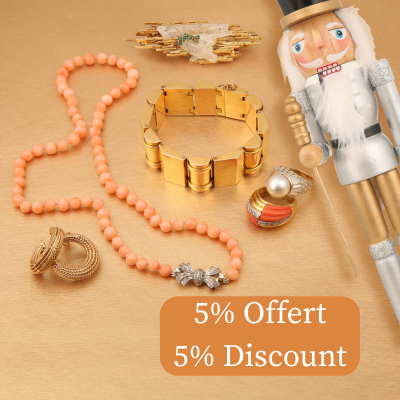Pierre Sterlé
The 1950’s Creativity

A YOUNG CREATOR
Pierre Sterlé was born in 1905 in Charenton-le-Pont, and grew up in a family environment that did not predispose him to a career in jewelry in any way. He lost his father during the First World War and following this event, his uncle, a jeweler on rue Castiglione, became his guardian. He was introduced to the world of jewelry and the profession of jeweler at that time.
In 1934, he launched his jewellery business on rue Sainte-Anne and then rue des Moulins.
From 1934 to 1939, he mainly designed jewelry (hair clips, clips, hat pins ...) for major jewelry houses such as Chaumet, Boucheron, Kirby or Puiforcat. He also made jewelry for his customers even if the majority of his time was devoted to the above mentioned Houses. In parallel, he also made leather goods decorated with precious metals and stones. Because of the quality of his work, he began to acquire more and more influential clients in the Parisian world -who usually made their purchases at Place Vendôme- such as Madame Lazard, Madame Renaud or Gaby Morlay.

To accommodate his clientele, he moved his workshop to 43 Avenue de l'Opéra in 1945.
Among his most famous customers are Colette (a friend before being a customer), Edwige Feuillère, Lise Delamare, Sidney Bechet, Léo Marjane...

Three years in a row, in 1953, 1954 and 1955, he received the DeBeers Diamond Award, a prize that’s a testament to the quality and originality of the craftsmanship of his house.
Known for never paying attention to manufacturing costs, Sterlé began to experience financial difficulties in 1955, when he launched his first fragrance "Huit-Huit", with notes of Bulgarian rose berry, jasmine and Japanese camellia. Indeed, the cost of the perfume had been miscalculated and it cost more than it was sold.
In 1959, he launched another perfume "Diam" with notes of wood, sap, narcissus, lily of the valley and fresh grass, which was also a commercial failure.

In the 1960s, due to the failure of his two perfumes, which cost the company a lot of money, and to a financial management that was not up to par with the quality of his creations, Pierre Sterlé had financial difficulties. At the same time, he was experiencing personal tragedies such as the illness of his wife and the death of his son, killed in a car accident.
In 1966, he exhibited at the Biennale des Antiquaires and the enthusiasm he saw for his jewelry there prompted him to leave his workshop and open his first boutique in 1969, 364 rue Saint-Honoré, with a storefront on Place Vendôme. This did not please his usual clientele, who had become more accustomed to the premises on the Avenue de l'Opéra.

But Sterlé's finances did not recover and he had to liquidate his company in 1976. Chaumet bought out his stock and hallmarked all unsigned jewelry in their name as well as hired him as a technical advisor.
At the end of his career, he was greatly inspired by the artistic collaboration he had with Beatrice de Plinval, a designer from Chaumet.
He died in 1978 in Paris.
STERLE STYLE
Pierre Sterlé's style is characterized by a new conception of jewelry and is defined as a modernization of baroque by Lucien François.
It is quite recognizable and was greatly inspired by nature "It was a mushroom, a branch, a leaf, sometimes an impression, a memory from which wonders were born" says Jürgen Schwarz in the book Sterlé joaillier Paris by Viviane Jutheau.

He made many brooches (which were very popular in the 1960s) and earrings representing birds, feathers and flowers.
A very precise and technical mastery is characteristic of Pierre Sterlé's work "When I call my neighbor a craftsman, he blushes with rewarded pride" said Colette in the Fanal bleu. He was nicknamed the “couturier” of jewelry.

Pierre Sterlé did not sketch his creations himself and preferred to employ people to sketch his jewels like the famous Jacques Desnoues (before 1960) or Yves Poussielgues (after 1960), which leaves us beautiful archives, preserved by Chaumet and visible in the very beautiful book of Viviane Jutheau: Sterlé Joaillier Paris, edited by Vecteurs. Up to three draftsmen were working in his company at the same time.
In 1957, he invented the "fil d’ange" or angel thread which consists of finely braided gold, which he would later incorporate into his creations.

If you are interested in Pierre Sterlé jewels, don’t hesitate to discover what les Pierres de Julie have to offer in the store…
We are also available for any free expertise of your Pierre Sterlé jewelry, for that you can send an email with your photos to contact@lespierresdejulie.com.
Whether you're interested in buying a piece of jewellery or a stone, a free jewelry appraisal or jewelry resale, Pierres de Julie welcomes you to its Parisian boutique in the Village Suisse, a stone's throw from the Ecole Militaire and the Esplanade des Invalides.
Nouveautés
- 3.400 €
5.250 €- 3.400 €
- Unit price
- / per
- 4.900 €
7.150 €- 4.900 €
- Unit price
- / per
- 2.900 €
- 2.900 €
- Unit price
- / per
- 12.800 €
- 12.800 €
- Unit price
- / per











